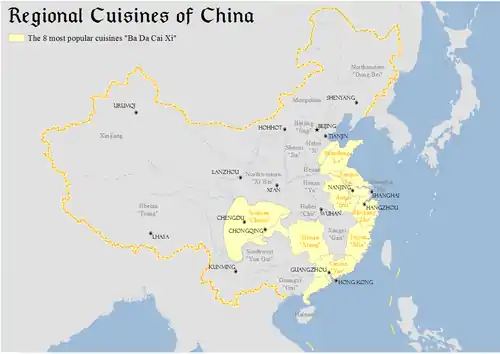Anhui cuisine
Anhui cuisine, alternatively referred to as Hui cuisine, is one of the Eight Culinary Traditions of Chinese cuisine. It is derived from the native cooking styles of the Huangshan region in southern Anhui Province.
| Anhui cuisine | |||||||
|---|---|---|---|---|---|---|---|
| Chinese | 安徽菜 | ||||||
| |||||||
| Hui cuisine | |||||||
| Chinese | 徽菜 | ||||||
| |||||||
 |
| Chinese cuisine |
|---|
|

Methods and ingredients
Anhui cuisine is known for its use of wild herbs, from both the land and the sea, and simple methods of preparation. Braising and stewing are common cooking techniques. Frying and stir frying are used much less frequently in Anhui cuisine than in other Chinese culinary traditions. Anhui cuisine consists of three styles: the Yangtze River region, Huai River region, and southern Anhui region. Anhui has ample uncultivated fields and forests, so the wild herbs used in the region's cuisine are readily available. Anhui cuisine is heavily associated with tofu, with Chinese folklore crediting the creation of tofu to the Han dynasty prince Liu An who hailed from Shou County (dubbed the "hometown of tofu").[1] According to Chinese legend, stinky tofu was created by Anhuinese scholar Wang Zhihe who sold his product in Beijing to make a living after failing the imperial examination. Anhui is the home of hairy tofu where it is a popular snack.
Notable dishes in Anhui cuisine
| English | Traditional Chinese | Simplified Chinese | Pinyin | Description |
|---|---|---|---|---|
| Bagongshan stinky tofu | 八公山臭豆腐 | 八公山臭豆腐 | bāgōngshān chòu dòufǔ | Also known as "four seasons tofu", is a traditional local snack in Huainan, Anhui. |
| Egg dumplings | 農家蛋餃 | 农家蛋饺 | nóngjiā dàn jiǎo | These dumplings, usually associated with rural cooking, use thin sheets of egg instead of flour for the wrapping. Egg dumplings traditionally use pork as a filling. In preparation, a ladle is lightly coated with oil and heated, well beaten eggs are spooned into the ladle and cooked until the mixture forms a dumpling wrapper. The pork filling is then spooned into the egg wrapping and the entire dumpling steamed. It is often served with soy sauce.[2] |
| Li Hongzhang chop suey | 李鴻章雜碎 | 李鸿章杂碎 | Lǐ Hóngzhāng zásuì | A popular dish named after Li Hongzhang, a prominent Qing dynasty statesman from Anhui Province. The dish, a complex soup, is somewhat salty with a taste of sweetness. Many ingredients are used in the soup but the most common ones include sea cucumber, fish, squid, bamboo, dry bean curd, chicken, ham and assorted vegetables. |
| Luzhou roast duck | 廬州烤鴨 | 庐州烤鸭 | Lúzhōu kǎoyā | A popular dish from Hefei which first gained recognition when it was offered as tribute to the imperial court. While not as well known internationally as Peking duck, Luzhou roast duck has won awards and distinction within China. |
| Potato cellophane noodles | 紅薯粉絲 | 红薯粉丝 | hóngshǔ fěnsī | Sweet potato starch vermicelli.[3] |
| Sanhe shrimp paste | 三河蝦糊 | 三河虾糊 | sānhé xiāhú | A regional dish that originated in Sanhe, Feixi County, but can now be found in Hefei. The dish's main components are rice flour and a regional species of small white shrimp. The shrimp are stir fried with leeks and soy sauce, while the rice flour is soaked in water and later added to the shrimp. The dish is brown in colour and tastes pleasantly salty. It is eaten with a spoon. |
| Steamed stone frog | 清蒸石蛙 | 清蒸石蛙 | Qīngzhēng shí wā | The dish has been proven to be rich in protein and other nutrients. |
| Wushan imperial goose | 吳山貢鵝 | 吴山贡鹅 | wúshān gòng'é | The history of Wushan imperial goose dates back to the Tang dynasty. The dish is lightly coloured and has a fragrant and salty taste. |
